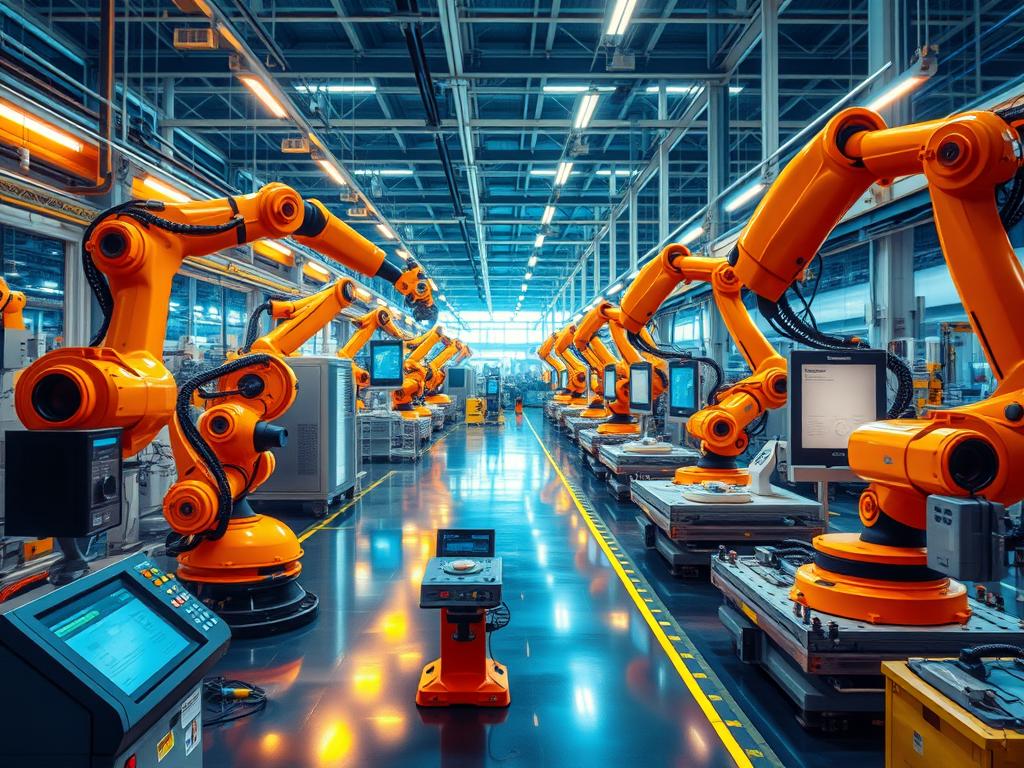Smart factory initiatives will drive the manufacturing sector, according to 86% of executives. IoT sensors are revolutionizing manufacturing processes. This digital shift is reshaping the industry landscape.
Process automation is evolving rapidly. IoT sensors enable proactive quality management and process optimization. They capture vital data points along production lines.
These tiny devices measure pressure, vibration, temperature, and humidity. They create a smarter, more efficient, and responsive manufacturing ecosystem. The potential for growth is enormous.
By 2025, over 75 billion devices will connect via IoT technology. This surge in connectivity is driving a new manufacturing era. Real-time monitoring and actionable insights are becoming standard.
IoT integration is part of the Industry 4.0 movement. This revolution aims to boost operational efficiency and product quality. Advanced technologies are at the forefront of this change.
IoT sensors are reshaping manufacturing foundations. They promise a future of unmatched productivity and innovation. The industry is poised for unprecedented growth and transformation.
Introduction to Process Automation in Manufacturing
Process automation is changing manufacturing. It uses robotics, AI, and IoT to create smart factories. This boosts productivity, reduces errors, and improves product quality.
What is Process Automation?
Process automation uses tech to do repetitive tasks and streamline operations. In manufacturing, it includes various systems.
- Fixed automation for high-volume production
- Programmable automation for batch processes
- Flexible automation for varying volumes
- Industrial robotics for tasks like assembly and welding
These systems have evolved from simple conveyor belts. Now, they’re complex networks of machines, sensors, and control systems. They use advanced tools like HMIs, CNC machines, and SCADA systems.

The Role of IoT in Modern Manufacturing
IoT connects smart devices and systems through networks. This allows them to perform tasks and share info. IoT helps manufacturers improve processes and adapt to market changes.
- Discover and automate labor-intensive processes
- Improve efficiency across operations
- Adapt quickly to market dynamics
IoT sensors collect data on temperature, pressure, and flow rates. Actuators control motors or valves. Robotic process automation benefits both production and business operations.
| Automation Type | Benefits |
|---|---|
| Workflow Automation | 25% increase in factory productivity |
| Business Process Automation | Optimized sales, inventory tracking, and procurement |
| Intelligent Manufacturing Systems | Frees up employee time from routine tasks |
IoT and automation optimize human power, machinery, and robotics. This integration transforms traditional operations. It enhances customer experience and drives efficiency across the value chain.
Key IoT Technologies Reshaping Manufacturing
IoT technologies are revolutionizing manufacturing. They drive task automation and reshape processes. Let’s explore the key elements behind this change.
Smart Sensors: The Eyes and Ears of Industry
Smart sensors are vital in modern manufacturing. They capture data on equipment health, environmental conditions, and production processes. By 2020, IoT tech investment may reach $70 billion, making smart sensors common in factories.

Edge Computing: Rapid Data Processing
Edge computing processes data near its source. This automation software cuts latency and bandwidth use, allowing real-time decisions. By 2025, 55.7 billion IoT devices will create 80 ZB of data.
Edge computing will be crucial for efficient operations. It helps manage the massive amount of data produced by IoT devices.
Wireless Connectivity: The Invisible Thread
Wireless solutions, especially LPWANs, are key for large-scale IoT use. These networks offer long-range communication with low power use. They’re perfect for connecting thousands of endpoints in manufacturing facilities.
| IoT Technology | Impact on Manufacturing |
|---|---|
| Smart Sensors | 45% of field assets benefit from predictive maintenance |
| Edge Computing | 31% improvement in on-time delivery |
| Wireless Connectivity | 28% reduction in project timelines |
These automation tools are boosting efficiency and productivity in manufacturing. More businesses are embracing digital transformation. The potential for growth through IoT tech is endless.
Real-World Applications of IoT Sensors
IoT sensors are changing manufacturing through smart automation and process optimization. They’re improving production, from maintenance to quality control and supply chain management. These technologies are making factories smarter and more efficient.
Predictive Maintenance in Manufacturing
IoT sensors on factory equipment spot issues, cutting downtime and waste. This smart automation has boosted IoT use in manufacturing by 53% from 2021 to 2024. Process automation, the top IoT use, is now used by 57.5% of companies.
Quality Control Through Real-Time Monitoring
Real-time IoT monitoring greatly improves quality control. Quality management adoption has jumped to 55% from 30% in 2021. Most companies see returns in less than two years. On average, major IoT rollouts boost product quality by 4.6%.
Supply Chain Optimization
IoT sensors are reshaping supply chains with real-time inventory tracking and process improvements. Real-time inventory management use has soared to 54%, up 35 points since 2021. It’s set to receive the biggest investment boost in smart supply chains.
| IoT Use Case | Adoption Rate (2024) | Increase from 2021 |
|---|---|---|
| Process Automation | 57.5% | 24.5% |
| Quality Control | 55% | 25% |
| Energy Monitoring | 55% | 35% |
| Real-time Inventory Management | 54% | 35% |
These numbers show how crucial IoT sensors are becoming in manufacturing. A whopping 92% of companies report positive returns from IoT. Clearly, these tools are driving big gains in efficiency, quality, and cost savings.
Benefits of Implementing IoT Solutions
IoT solutions are changing manufacturing through digital transformation and intelligent automation. These technologies offer major advantages to companies that embrace this shift. They boost efficiency and improve product quality.
Increased Operational Efficiency
IoT devices boost productivity by streamlining processes. Toyota saw a 30% increase in productivity after implementing smart manufacturing solutions. Real-time monitoring allows for quick adjustments, reducing downtime and costs.
Cost Reduction and Resource Management
IoT-driven predictive maintenance leads to big cost savings. General Electric cut maintenance costs by up to 20% using this approach. Energy use in manufacturing can drop by up to 20% with IoT, promoting cost-efficiency and sustainability.
Enhanced Product Quality and Consistency
IoT technology greatly improves product quality. Bosch achieved a 10% reduction in scrap rates through IoT-driven quality control. Digitization and automation have led to over 65% reduction in manufacturing deviations.

| Benefit | Impact |
|---|---|
| Productivity Increase | 30% (Toyota) |
| Maintenance Cost Reduction | Up to 20% (General Electric) |
| Energy Consumption Reduction | Up to 20% |
| Scrap Rate Reduction | 10% (Bosch) |
| Manufacturing Deviation Reduction | Over 65% |
These benefits show the power of IoT in manufacturing. Companies can achieve big improvements in efficiency, cost management, and product quality. IoT is reshaping the future of manufacturing.
Future Trends in Process Automation and IoT
Process automation and IoT in manufacturing are evolving quickly. New trends are reshaping production and efficiency. Let’s explore key developments defining the future of smart manufacturing.
Integration of AI and Machine Learning
AI and machine learning are vital to process automation. They enable complex decision-making and pattern recognition beyond simple task automation.
Hyper-automation is gaining popularity in large enterprises. It combines technologies like RPA, AI, and machine learning for sophisticated automated workflows.
Cybersecurity Considerations in IoT Networks
Cybersecurity is crucial as IoT networks expand in manufacturing. Protecting against threats is vital with more connected devices.
Edge computing enhances security by processing data locally. This improves data protection and increases processing speed and efficiency.
The Sustainability Factor in Manufacturing Automation
Sustainability drives manufacturing automation. IoT solutions optimize energy use, reduce waste, and improve resource management.
In 2020, manufacturing used 33% of total U.S. energy. This highlights the need for energy optimization strategies.
Industrial Internet of Things (IIoT) sensors enable real-time adjustments. They’re crucial for efficient resource use and data monitoring.


